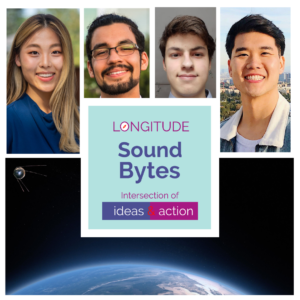
Longitude Sound Bytes
Ep 86: Edge of Space (Listen)
Jaena Kim
Welcome back to Longitude Sound Bytes, bringing innovative insights from around the world directly to you. Join us as we blast off to the edge of space as we continue to explore the Longitudes of Imagination series. I’m Jaena Kim, Longitude fellow and law student at the University of Ottawa.
Blake Moya
I’m Longitude fellow Blake Moya, a Statistics PhD student at the University of Texas at Austin. Join us throughout January as we launch into the universe of space technology and even catch up with a NASA microbiologist.
Tony Zhou
Hi everyone, I am Tony Zhou and I am a Longitude fellow from Yale University.
Quint Smits
Nice to meet you. I am Quint Smits. I am a student of Cognitive Science and Artificial Intelligence at Tilburg University here in the Netherlands.
Jaena
Find out how STEM and imagination gravitate towards one another and result in successfully sending satellites nearly the size of rubix cubes into outer space, or putting a DNA sequencer on the International Space Station.
Tony
The Endurance project is an ongoing story of unexpected surprises with an admirable goal of democratizing and increasing accessibility to space, rocketing together some of the most brilliant minds who share a passion for the cosmos.
Blake
Keep listening for a sneak preview of the upcoming Edge of Space episodes with guests Naeem Altaf, Minsik Lee, and Sarah Wallace.
Sarah Wallace
“…that desire to explore, and I feel like as a human race, the minute we stop exploring, and the minute we stop, you know, trying to advance technology and understanding and learning, it’s, I can’t- it’s kind of like what, you know, what for? I feel like, that’s- there’s so many questions. And, you know, a lot of people, I think NASA is trying to do a better job. And I think that’s something we’ll continue to do, to show how many things have come to benefit life on Earth because of the advances we’ve made in space. And because of the technologies we’ve developed in space. You know, we’ve made life on Earth better for so many. And I will say, that’s one of the mottos of the International Space Station is, you know, in space, for Earth, like we’re doing things there, to come back and translate to Earth.”
Quint
Indeed. If you have got this infinite sandbox why just sit on one grain of sand.
Jaena
Quint and Sarah further explore the positive impact of space exploration, including a big IF, of if extraterrestrial DNA were ever to be found. Tune in to their episode to find out what Sarah Wallace, a NASA microbiologist, has to say. Tony, Naeem seemed to share a similar sentiment on the positive impact of space technology.
Tony
Yes, I could immediately tell how enthusiastic Naeem was talking about all things space. He really cares about creating technology and products that have lasting impact on humanity.
Naeem Altaf
“We were looking at different projects to do for space tech, and one of the projects which we- and we can talk about that later, was the edge computing within an International Space Station for DNA sequencing. So while we were working on projects, I wanted to always look for the angle ‘tech for good.’ Something we can give back to the society in healthcare and for future generations, and basically inspire our next generation.”
Jaena
It seems like these leaders in the field of space microbiology and space technology are all motivated to help the people back on earth. Blake, I think your episode with Minsik highlights the volatile process when working on a still-emerging field.
Blake
Exactly, launching a satellite computer comes with very similar problems as the ones involved with the Mayflower Autonomous Ship. Both required careful programming for what the device should do if there was a problem, since no one can get all the way out into the ocean or the stratosphere to help. For our listeners interested in edge computing/CubeSat, Minsik and I will talk about the problems and preparation that come with computing in space in our upcoming episode.
Minsik Lee
“You may be aware that there was a project called Mayflower. That project developed an autonomous boat. From the IBM side, we applied IT stack and then also provided operation to support that autonomous boat. In our perspective, that kind of use case for the edge computing environment. And then one day we just thought, why don’t we apply the same technology onto space, so we just had that idea about two years ago. And then we met people in NASA, and then we shared these ideas. And then we have some opportunities to apply software defined technologies on Space Station or satellites. Then we started a project called Endurance. That’s our own CubeSat. And so we will launch this one next year. And then our goal is to have kind of a playground. That way anybody can test their code in our CubeSat environment.”
Blake
Minsik also encourages people to pay attention to the latest trends in tech, like edge computing, as a source of inspiration for bold ideas. Learning how to use these new tools can help you bring those ideas to the world, or to space.
Tony
Since the exponential increase in data and computing power, computational tools, such as Edge Computing, allow for increased efficiency and comprehensive data processing and analytics by using data servers closer to the point of creation. Data generated at the point of creation can be analyzed with the results sent back to the ground network. To find out more about edge computing, make sure to check out my episodes with Naeem.
Blake
The connection between the satellite and the ground network, which mediates the transfer of so much data through so little bandwidth, brings communication to the center stage of this project. That really reflects the motive of the whole Endurance mission: to facilitate communication between industry professionals, students, and software and expose a whole generation of students to space tech.
Jaena
That’s a really good point, Blake. I think our audience will really enjoy hearing about how the hard work done on Earth only to send things far off into outer space is actually motivated by and to help most, us, the people right here on our planet. At the end of the day, these space experts all work towards the common goal of advancing the future of humanity, and the presence of space might just be orbiting around our everyday lives more than we think. You’ll also find that Naeem, Minsik, and Sarah all share valuable big picture reflections from their work in space technology that any young professional will find helpful. Quint ground us back to Earth.
Quint
What is the best piece of life advice you can give?
Sarah Wallace
“chasing and pursuing your passion, which I think- that’s number one, always chase and pursue your passion, never give up. But you don’t have to be good at everything. Find the one thing that you’re good at, and go all in on that and love it and become an expert in that and figure out how to use it and harness it to make your field better.”
Tony
Sarah’s advice is just a hint of one of the most technically enriched Sound Byte series yet, laced with the latest space tech but also advice that’s transferable to, as Quint would say –
Quint
The moon and beyond.
Tony
This brings us to the end of our introductory episode.
Blake
We can’t wait for you to tune in to the continuation of the Longitudes of Imagination series.
Jaena
Follow Longitude on Facebook, Instagram, and LinkedIn to make sure you don’t miss the release of the Edge of Space series. You can also visit our website at Longitude.site for more information and content.

